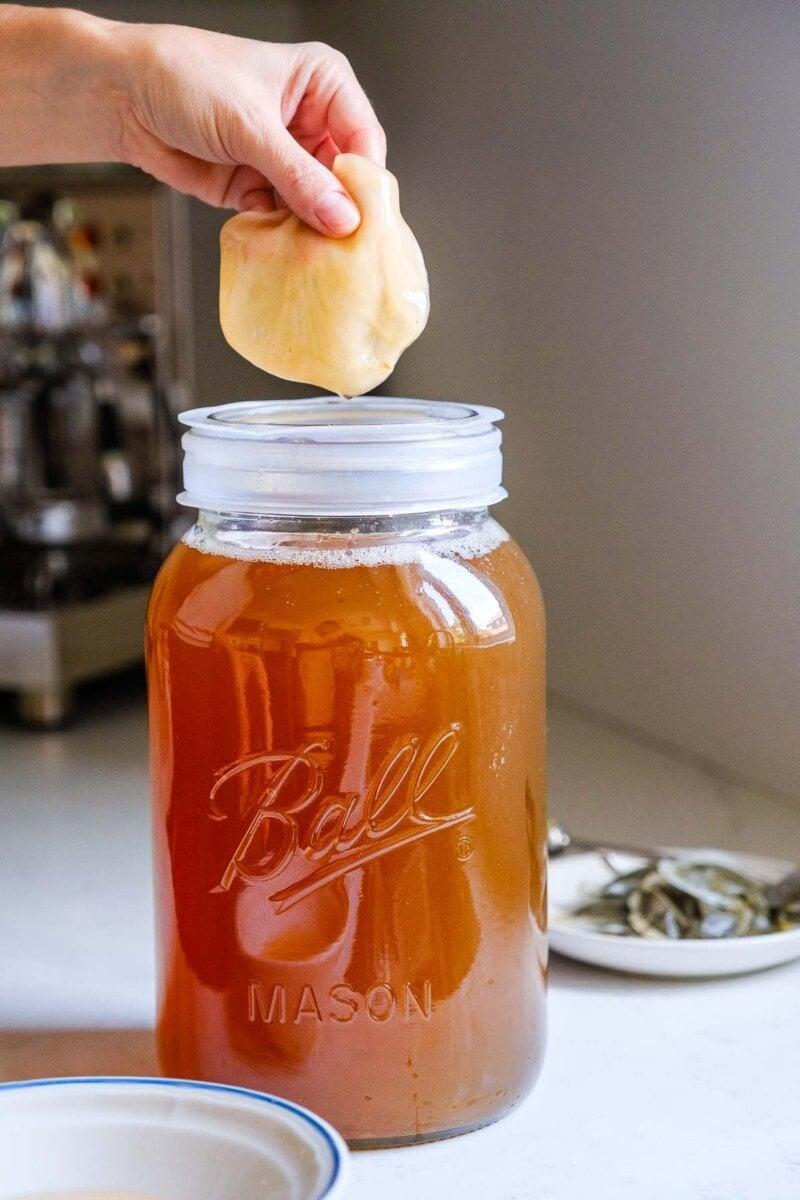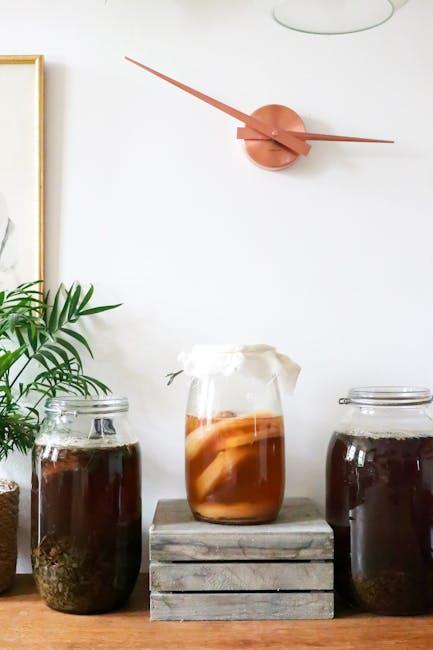Table of Contents
- Understanding the Basics of Kombucha Brewing
- Essential Ingredients for Crafting Your Perfect Kombucha
- Step-by-Step Guide to Fermentation Mastery
- Flavors and Variations to Elevate Your Kombucha Experience
- Troubleshooting Common Kombucha Brewing Issues
- Q&A
- Closing Remarks


Understanding the Basics of Kombucha Brewing
Kombucha brewing is a delightful and fascinating process that transforms sweetened tea into a tangy, fizzy beverage. The magic occurs through fermentation, where beneficial bacteria and yeast feast on the sugar in the tea, creating a complex flavor profile and a host of health benefits. To begin your journey into kombucha, gather essential ingredients that include tea leaves, sugar, water, and a SCOBY (symbiotic culture of bacteria and yeast). Each element plays a critical role in the fermentation process, influencing the taste and quality of the final product.
The brewing process typically unfolds in two stages. First, during the primary fermentation, brew your sweet tea, allow it to cool, and then add the SCOBY. This mixture should be kept in a warm, dark place for about a week, allowing the SCOBY to work its magic. After this period, a taste test will help determine if it’s ready to move to the next phase. If you prefer a stronger or sweeter kombucha, you can let it ferment longer or adjust sugar levels. The next step is the secondary fermentation, where you can add flavors like ginger, berries, or herbs to the mixture before bottling. This phase usually lasts an additional 3 to 7 days and enhances the fizz and flavor.
Understanding the brewing timeline and environment is crucial for successful kombucha creation. Environmental factors such as temperature and exposure to light can significantly impact fermentation. Here’s a quick overview to keep in mind:
| Factor | Optimal Range |
|---|---|
| Temperature | 68-85°F (20-29°C) |
| Fermentation Time | 7-14 days (primary) |
| Flavoring Time | 3-7 days (secondary) |
With practice and experimentation, you can refine your technique and develop a unique kombucha that reflects your taste preferences. Enjoy the process, and soon you’ll be sipping your refreshing homemade brew!


Essential Ingredients for Crafting Your Perfect Kombucha
Crafting a delightful batch of kombucha begins with selecting high-quality ingredients that will enhance flavor and ensure a successful fermentation process. The most vital component is the starter culture, commonly known as SCOBY (Symbiotic Culture Of Bacteria and Yeast). This unique organism transforms sweet tea into your fizzy elixir. When purchasing or making your own SCOBY, choose a healthy and well-formed culture to achieve that tangy finish.
Next, pay attention to the type of tea you use. Black tea is traditional, delivering robust flavor and richness. However, oolong, green, or even herbal teas can provide intriguing variations. Each type brings its unique qualities to the brew, so don’t hesitate to experiment with blends. Pairing your tea with the right sweetener is equally essential. Organic cane sugar is commonly used, as it feeds the SCOBY effectively, but alternative sweeteners like honey or maple syrup can also complement your flavor profile, imparting a distinct taste.
Lastly, consider the flavoring agents that will elevate your kombucha. After the primary fermentation, the secondary fermentation phase introduces fruits, spices, or herbs. Popular additions include slices of fresh ginger, berries, or citrus peel, which not only infuse the drink with botanical aromas but also enhance its nutritional value. Remember to include a bit of ginger for that extra zing or mint for a refreshing twist. When crafting your perfect kombucha, balance your ingredients thoughtfully to create a harmonious blend that reflects your personal taste.


Step-by-Step Guide to Fermentation Mastery
To embark on your journey toward crafting the perfect kombucha, gather the essential ingredients and equipment. You’ll need:
- Tea: Black or green tea works best.
- Sugar: Regular granulated sugar is the key fermentable component.
- SCOBY: This is the symbiotic culture of bacteria and yeast that initiates fermentation.
- Starter tea: A cup of unflavored, previously fermented kombucha to kickstart the process.
- Filtered water: Chemical-free water is crucial for fermentation.
- Glass jar: A large jar for brewing; avoid metal and plastic.
- Cloth and rubber band: For covering the jar and allowing airflow while keeping contaminants out.
Start your fermentation by boiling water and steeping the tea for about 5-10 minutes. Once your tea has steeped, remove the tea bags or leaves and stir in sugar until dissolved. Allow the sweetened tea to cool to room temperature. Pour this mixture into your clean glass jar, add the starter tea, and gently place the SCOBY on top. Cover the jar with the cloth, securing it with the rubber band, and place it in a warm, dark spot to ferment for 7-14 days, depending on your taste preferences. The longer it ferments, the less sweet and more vinegary your kombucha will become.
After the fermentation period, it’s time to bottle your creation. Carefully remove the SCOBY and set it aside for your next batch. Pour the kombucha into bottles, leaving about an inch of headspace at the top. If you’d like to add flavor, consider infusing your kombucha with fruits, herbs, or spices at this stage. Seal the bottles tightly and allow them to undergo a secondary fermentation at room temperature for 3-7 days. To serve, refrigerate to halt fermentation, then enjoy your homemade kombucha, a probiotic-rich drink that can enhance gut health and refresh your palate!
Flavors and Variations to Elevate Your Kombucha Experience
Kombucha is not just a refreshing beverage; it’s a blank canvas waiting for your creative touch. Elevate your brew by experimenting with an array of flavors that can transform your kombucha from basic to extraordinary. A few additional ingredients can introduce exciting and complex profiles that tantalize your taste buds. Consider using:
- Fruits: Fresh or dried fruits like raspberries, peaches, or even mango offer a natural sweetness and vibrant color.
- Herbs and Spices: Fresh ginger, mint, or even a sprinkle of cinnamon can create refreshing or warming notes.
- Flowers: Edible flowers such as hibiscus or lavender can lend floral undertones and an aesthetic appeal.
Different fermentation times can also influence the final flavor of your kombucha. A shorter fermentation results in a sweeter drink, while a longer fermentation can produce a tangy, more effervescent concoction. For those seeking a more artisanal touch, consider infusing your kombucha in a second ferment with a combination of the following flavor profiles:
| Flavor Combination | Notes |
|---|---|
| Lemon & Ginger | Bright and zesty with a spicy kick. |
| Pineapple & Mint | Tropical and refreshing, perfect for summer. |
| Lavender & Chamomile | Soothing and aromatic, ideal for relaxation. |
By customizing your kombucha, you can not only cater to your palate but also impress your friends with unique flavor profiles. Don’t be afraid to mix and match until you find your perfect blend; the possibilities are endless. With a little experimentation, each batch can be a new adventure in taste and wellness. Enjoy the journey as much as the destination!


Troubleshooting Common Kombucha Brewing Issues
Brewing kombucha can be a fulfilling experience, but even the most seasoned brewers encounter issues from time to time. If you notice that your kombucha is unusually sweet, it might not be fermenting long enough. Possible solutions include:
- Ensure that the temperature is within the ideal range of 68°F to 85°F.
- Increase the fermentation time by a few days.
- Check your SCOBY’s health; a weak culture may need replacement.
Another common problem is the presence of mold, which can pose a significant risk. Mold typically appears as fuzzy spots on the surface of the SCOBY or the kombucha. If you spot any, it’s essential to act promptly. Here’s what you can do:
- Discard the entire brew, including the SCOBY.
- Clean all brewing equipment thoroughly with hot water and vinegar.
- Start fresh by using a new SCOBY and tea mixture.
If your final product is overly vinegary, you may have accidentally let it ferment for too long. This can be remedied by:
- Noting the fermentation time for future batches.
- Experimenting with different tea blends to find one that suits your preference.
- Aging the kombucha refrigerated to slow down fermentation.
Q&A
Q&A: Everything You Need to Know About Making Kombucha at Home
Q: What is kombucha? A: Kombucha is a fizzy, fermented tea that is often lauded for its potential health benefits. Made by fermenting sweetened tea with a symbiotic culture of bacteria and yeast (SCOBY), kombucha has been enjoyed for centuries and is known for its tangy, refreshing flavor.Q: What ingredients do I need to make kombucha? A: Making kombucha requires just a few basic ingredients:
- Tea: Black or green tea works best, though herbal teas can also be used.
- Sugar: Regular granulated sugar is ideal as it feeds the SCOBY.
- Water: Use filtered or distilled water for the best results.
- SCOBY: You can obtain a SCOBY from a friend or purchase one online.
- Starter tea: This is a bit of pre-made kombucha that helps kickstart the fermentation.
Q: How long does it take to make kombucha? A: The fermentation process usually takes between 7 to 21 days, depending on the desired taste and ambient temperature. A shorter ferment yields a sweeter beverage, while longer fermentation results in a more tangy flavor.
Q: Can I flavor my kombucha? A: Absolutely! Flavoring kombucha is one of the best parts of brewing at home. After the initial fermentation, you can add fruits, herbs, spices, or even other flavors like ginger or lavender. The second fermentation in sealed bottles helps to infuse these flavors while creating natural carbonation.
Q: What equipment do I need to brew kombucha? A: For brewing kombucha, you will need:
- A large glass jar (1-gallon size is ideal) for fermentation.
- A cloth cover and rubber band to protect your brew from contaminants while allowing it to breathe.
- A funnel and fine mesh strainer for bottling.
- Bottles (preferably glass) for the second fermentation.
Q: Is homemade kombucha safe to drink? A: Yes, homemade kombucha is safe to drink as long as you follow proper hygiene and brewing practices. Always use clean equipment, monitor the fermentation process, and ensure your SCOBY is healthy. If you notice any unusual changes, such as a foul smell or mold, discard the batch.
Q: What are the health benefits of kombucha? A: Kombucha is believed to have several health benefits due to its probiotic content, which can aid digestion, boost the immune system, and may help detoxify the body. However, scientific evidence is still being explored, so it’s best to enjoy kombucha as part of a balanced diet.
Q: Can I drink kombucha every day? A: Many people enjoy kombucha daily, but moderation is key. Starting with 4 to 8 ounces per day is advisable, especially if you are new to fermented foods, to assess how your body reacts.
Q: How do I troubleshoot common kombucha problems? A: Common issues include overly sweet kombucha (not fermented long enough), overly sour kombucha (fermented too long), or no carbonation (not sealed properly in bottles). Adjusting the fermentation time and ensuring a tight seal during the second fermentation can help troubleshoot these problems.
Q: Where can I find more kombucha recipes? A: There are countless resources available online, including blogs, YouTube channels, and forums dedicated to kombucha brewing. Experimenting with different flavors and techniques will help you discover the perfect kombucha recipe for your taste!
